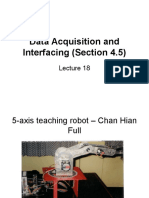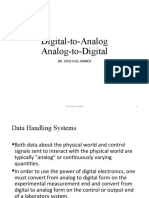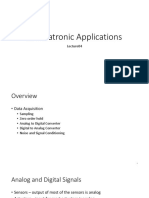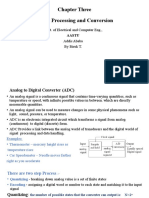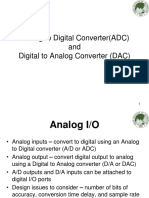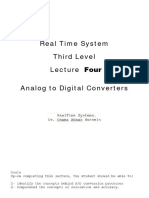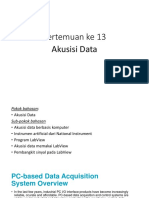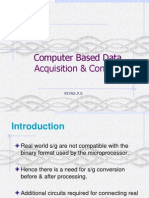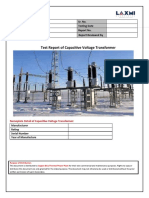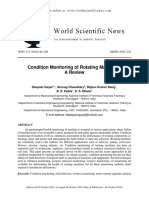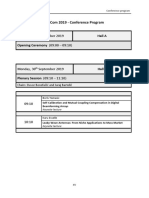Data Acquisition and
Interfacing
Lecture 17
�5-axis teaching robot Chan Hian
Full
�System Set-up
Interfacing card installed in CPU
�PCL-812PG
PCL-839
�drivers
Mechanical parts
transmission, stepper motors
�PC-based Process Control Monitoring System - Chai
Song Ling
�PC and Data Acquisition
System
System Set-up
�Data Acquisition system
sensor and signal
conditioner
��Introduction
A data acquisition system consists of many
components that are integrated to:
Sense physical variables (use of transducers)
Condition the electrical signal to make it
readable by an A/D board
Convert the signal into a digital format
acceptable by a computer
Process, analyze, store, and display the
acquired data with the help of software
�Data Acquisition System
Block Diagram
�Flow of information in DAQ
1.
2.
3.
4.
5.
6.
7.
Input transducer measure physical quantity
Output from transducer conditioned i.e. amplify, filter,
conversion
Conditioned analog signal digitized using ADC
Digital information acquired, process and record by
computer
Modify physical signal, digital output converted to
analog by DAC
Analog signals are conditioned
Output transducer interact with physical variables
�Transducers
Sense physical phenomena and translate it into
electric signals.
Examples:
Temperature
Pressure
Light
Force
Displacement
Level
Electric signals
ON/OFF switch
�Signal Conditioning
Electrical signals are conditioned so they can
be used by an analog input board. Types of
signal conditioner:
Amplification
Isolation
Filtering
Linearization
�Analog to Digital (A/D) Converter
Input signal
Sampling rate
Throughput
Resolution
Range
Gain
�A/D Converter: Input Signal
Analog
Signal is continuous
Example: strain gage. Most transducers
produce analog signals
Digital
Signal is either ON or OFF
Example: light switch.
�A/D Converter: Sampling
The data is acquired by an ADC using a
process called sampling.
Sampling a analog signal - taking a sample of
the signal at discrete times.
�A/D Converter: Sampling Rate
Determines how often conversions take
place.
The higher the sampling rate, the better.
Analog
Input
4 Samples/cycle
16 Samples/cycle
8 Samples/cycle
� This rate at which the signal is sampled sampling frequency.
Sampling frequency - determines the quality
of the analog signal that is converted.
Higher sampling frequency achieves better
conversion of the analog signals
A signal of lower frequency is generated
from such a process (this is called aliasing).
Issermann:
Ts /15 < sampling time< Ts/6
Ts = settling time = 90% complete
�A/D Converter: Sampling Rate
Aliasing
Acquired signal gets distorted if sampling
rate is too small.
�AnalogAnalog
-toto-Digital Conversion
An ADC converts an analog
voltage to a digital number.
The digital number represents
the input voltage in discrete
steps with finite resolution.
ADC resolution is determined
by the number of bits that
represent the digital number.
�Analog to Digital Conversion for a 3-bit ADC
�A/D Converter: Resolution
�Resolution
The resolution = is a function of number of bits ADC uses to
represents digital data
The higher the resolution, the higher voltage range is broken
into, and therefore, the smaller the detectable voltage change.
A 8 bit ADC gives 256 levels (2^8) compared to a 12 bit ADC
that has 4096 levels (2^12).
Hence, 12 bit ADC will be able to detect smaller increments of
the input signals then a 8 bit ADC.
LSB or least significant bit is defined as the minimum
increment of the voltage that a ADC can convert
E.g. - For full scale input signal of 10V, the LSB for a 3-bit
ADC corresponds to 10/2^3=1.25V. However, for a 12 bit
ADC, LSB = 10/2^12=10/4096=2.44mV.
� LSB varies with the
operating input voltage
range of the ADC.
If the full scale of the
input signal is 10V than
the LSB for a 3-bit
ADC corresponds to
10/2^3=1.25V
For a 12 bit ADC, LSB=
10/2^12 =10/4096
=2.44mV.
Resolution of ADC,
X axis is analog input
�Exercise 1
An ADC with word length of 10 bits. If the
input analogue signal range is 10 V, what
is the resolution of this ADC?
�Answer
The resolution:
VFS 10V
= 10 = 9.8 mV
n
2
2
�Exercise 2
Consider a thermocouple giving an output
of 0.5 mV/0C. What will be the word length
required when its output passes through
an ADC if temperatures from 00 to 2000C
are to be measured with resolution of
0.50C?
�Answer
The full scale output from sensor:
200 0.5= 100 mV
With word length n, this voltage is divided into
100/2n mV steps
For a resolution of 0.50C, we must be able to detect a
signal from sensor 0.5 0.5=0.25mV
Thus, the word length:
0.25 = 100/2n;
n = 8.6
9-bit word length is required
�Bits
The smallest unit in
digital signal is the bit,
a contraction of the
more descriptive
phase of binary digit.
Off
0
On
1
A bit is a single
element in digital
signal, having only two
possible states: on
(indicating 1) or off
(indicating 0).
�Bytes
Off Off On Off Off Off Off On
0 0 1 0 0 0 0 1
Bits are organized into
larger units called bytes,
the basic unit of
information in a computer
system.
A basic byte contains 8 bits.
The total amount of
information it can convey is
28 (=256) possible
combinations.
1 byte = 8 bit = 2 nibble
2-byte = 16 bit, 4-byte = 32bit
1 Kbyte = 1210byte = 1024 byte
1 Mbyte = 1210210= 1,018,576byte
1GB = 230
1TB = 240
�AnalogAnalog
-toto-Digital Converter
Theory
Analog
Input
N-bit
Digital Output
N-bit
ADC
3-bit ADC Scale
1 Volt
. 875
. 75 Volt
. 625
1
1
Step Size = N = 3
2
2
= 0.125 V
.5V
. 375
. 25 V
. 125
0 Volt
Analog Input Signal
111
110
101
100
011
010
001
000
Digital Output Code
�Example of Encoding (8(8-bit
system)
Data Bus Line D7
Value
D6
27
(128)
D5
26
(64)
D4
25
(32)
D3
24
(16)
Decimal Value
Binary Code
D2
D1
D0
23
(8)
22
(4)
21
(2)
20
(1)
167
1
�Encoding (8(8-bit Bus, 0
0-5 V Input)
Analog Input (V)
Decimal Number
Digital Output
0000 0000
1.2
1.2
255 = 61.2 61
5.0
0011 1101
3.7
3.7
255 = 188.76 189
5 .0
10111101
255
1111 1111
�Numbering system binary, decimal, hexadecimal
Decimal
Hexadecimal
Binary
0000
0001
0010
0011
0100
0101
0110
0111
1000
1001
10
1010
11
1011
12
1100
13
1101
14
1110
15
1111
�Numbering system binary, decimal,
hexadecimal
010111101011010100102=
26214410 + 6553610 + 3276810 + 1638410 + 8192
+ 204810 + 51210 + 25610 + 6410 + 1610 + 210 =
38792210
Compare this to the conversion to hexadecimal,
where each group of four digits can be
considered independently, and converted directly:
010111101011010100102=
0101 1110 1011 0101 00102=
5
E
B
5
216 = 5EB5216
�Elementary Bus Structure
Microprocessor
Monitor
ROM
Optional
User ROM
System
& User
RAM
Address Bus
Data Bus
Keyboard
System
Input/Output
Addr bus which addr to go
Data bus data from CPU to addr
Control bus command from CPU
Display
User
Input/Output
�http://www.chassisplans.com/PDF/T4I_Reference_
Manual.pdf
�A schematic diagram of Data Acquisition System
�Example of Computer DAQ
System
DAQ Board
Trigger
Sensor
Timer
Digital Control
Interrupt
Circuit
Instrumentation
Amplifier
Input
Strobe
+
Bridge
Filter
S/H
Display
Control
A/D
Parallel/Series Computer
Input Port
D/A
Parallel/Series
Output Port
Output Strobe
�Multiplexer
Device where
computer reads
information from
various channel one
at a time
Electronic switch
Computer instruct
MUX select particular
channel and the data
are read and
processed
�Sample and hold
Take the snapshot of the sensor signal
and hold the value
Switch connect the capacitor and the
capacitor hold the value until the new
sample is acquired
�Data Acquisition Software
It can be the most critical factor in
obtaining reliable, high performance
operation.
Transforms the PC and DAQ hardware
into a complete DAQ, analysis, and
display system.
Different alternatives:
Programmable software.
Data acquisition software packages.
�Programmable Software
Involves the use of a programming
language, such as:
C++, Visual C++
BASIC, Visual Basic + Add-on tools (such
as VisuaLab with VTX)
Fortran
C#
Advantage: flexibility
Disadvantages: complexity and steep
learning curve
�Data Acquisition Software
Does not require programming.
Enables developers to design the
custom instrument best suited to their
application.
Examples: TestPoint, SnapMaster,
LabView, DADISP, DASYLAB, etc.
�KPCI-3108
�End of Lecture 17
